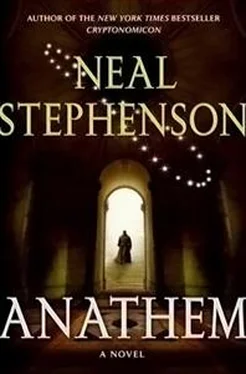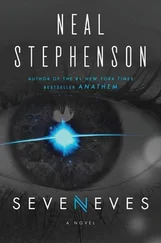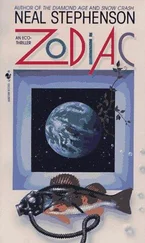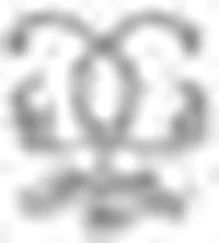Why had Grandsuur Tamura directed the first question at me? Probably because I’d been transcribing those interviews with Fraa Orolo, and had an advantage over the others. I decided to frame my answer accordingly. “Well, the extras—”
“The Sæculars,” Tamura corrected me.
“The Sæculars know that we exist. They don’t know quite what to make of us. The truth is too complicated for them to keep in their heads. Instead of the truth, they have simplified representations—caricatures—of us. Those come and go, and have done since the days of Thelenes. But if you stand back and look at them, you see certain patterns that recur again and again, like, like—attractors in a chaotic system.”
“Spare me the poetry,” said Grandsuur Tamura with a roll of the eyes. There was a lot of tittering, and I had to force myself not to glance in Tulia’s direction.
I went on, “Well, long ago those patterns were identified and written down in a systematic way by avout who make a study of extramuros. They are called Iconographies. They are important because if we know which iconography a given extra—pardon me, a given Sæcular—is carrying around in his head, we’ll have a good idea what they think of us and how they might react to us.”
Grandsuur Tamura gave no sign of whether she liked my answer or not. But she turned her eyes away from me, which was the most I could hope for. “Fid Ostabon,” she said, staring now at a twenty-one-year-old fraa with a ragged beard. “What is the Temnestrian Iconography?”
“It is the oldest,” he began.
“I didn’t ask how old it was.”
“It’s from an ancient comedy,” he tried.
“I didn’t ask where it was from.”
“The Temnestrian Iconography…” he rebegan.
“I know what it’s called. What is it? ”
“It depicts us as clowns,” Fraa Ostabon said, a little brusquely. “But…clowns with a sinister aspect. It is a two-phase iconography: at the beginning, we are shown, say, prancing around with butterfly nets or looking at shapes in the clouds…”
“Talking to spiders,” someone put in. Then, when no reprimand came from Grandsuur Tamura, someone else said: “Reading books upside-down.” Another: “Putting our urine up in test tubes.”
“So at first it seems only comical,” said Fraa Ostabon, regaining the floor. “But then in the second phase, a dark side is shown—an impressionable youngster is seduced, a responsible mother lured into insanity, a political leader led into decisions that are pure folly.”
“It’s a way of blaming the degeneracy of society on us—making us the original degenerates,” said Grandsuur Tamura. “Its origins? Fid Dulien?”
“ The Cloud-weaver, a satirical play by the Ethran playwright Temnestra that mocks Thelenes by name and that was used as evidence in his trial.”
“How to know if someone you meet is a subscriber to this iconography? Fid Olph?”
“Probably they will be civil as long as the conversation is limited to what they understand, but they’ll become strangely hostile if we begin speaking of abstractions…?”
“Abstractions?”
“Well…let’s say anything that comes to us from our mother Hylaea.”
“Level of dangerousness, on a scale of 1 to 10?”
“Given what happened to Thelenes, I’d say 10.”
Grandsuur Tamura didn’t favor the answer. “I can’t be too hard on you for over -estimating the risk, but—”
“Thelenes was executed in an orderly judicial proceeding by the Sæcular Power—not a mob action,” volunteered Lio, “and mob actions are less predictable, thus, more difficult to defend against.”
“Very good,” said Grandsuur Tamura, obviously surprised to hear such a cogent answer coming from Lio. “So let us rate its level of danger as 8. Fid Halak, what is the origin of the Doxan Iconography?”
“A Praxic Age moving picture serial. An adventure drama about a military spaceship sent to a remote part of the galaxy to prevent hostile aliens from establishing hegemony, and marooned when their hyperdrive is damaged in an ambush. The captain of the ship was passionate, a hothead. His second-in-command was Dox, a theorician, brilliant, but unemotional and cold.”
“Fid Jesry, what does the Doxan Iconography say of us?”
“That we are useful to the Sæcular Power. Our gifts are to be celebrated. But we are blinded, or crippled—take your pick—by, er…”
“By the very same qualities that make us useful,” said Fid Tulia. Which was why I couldn’t get her out of my mind: in a heartbeat, she could go from blubbering to being the cleverest person in the room.
“How to identify one who is under the influence of the Doxan Iconography? Fid Tulia, again?”
“They’ll be curious about our knowledge, impressed by us, but patronizing—certain that we must be subordinated to intuitive, common-sense leaders.”
“Danger level? Fid Branch?”
“I would put it very low. It is basically the situation we are living in anyway.”
This got a laugh, which Grandsuur Tamura didn’t like very much. “Fid Ala. What does the Yorran Iconography have in common with the Doxan?”
Suur Ala had to think for a minute before trying: “Also from a Praxic Age entertainment serial? But it was an illustrated book, wasn’t it?”
“Later they made moving pictures of it,” put in Fraa Lio.
Someone muttered a hint into Ala’s ear, and then she remembered everything. “Yes. Yorr is identified as a theorician, but if you see how he actually spends his time, he’s really more of a praxic. He has turned green from working with chemicals, and he has a tentacle sprouting from the back of his skull. Always wears a white laboratory smock. Criminally insane. Always has a scheme to take over the world.”
“Fraa Arsibalt, what iconography surrounds the Rhetors?”
He was so ready. “Fiendishly gifted at twisting words and confusing Sæculars—or, what is worse, influencing them in ways so subtle they don’t even know it’s happening. They use Unarian maths to recruit and groom minions, whom they send out into the Sæcular world to get influential positions as Burgers—but in truth they are all puppets of a Rhetor conspiracy.”
“Well, that one makes sense, anyway!” said Fid Olph.
Everyone looked at him to make out whether he was joking. He looked taken aback.
“Guess we know which order you’ll be signing up for!” said one irritated suur, who everyone knew was headed for the New Circle.
“Because he’s a Procian-hater? Or just because he’s socially inept?” said one of her companions in a low voice that was, however, clearly audible.
“That’s enough!” said Grandsuur Tamura. “The Sæculars don’t know about the differences between our Orders and so all of us—not just the Procians—are equally vulnerable to the iconography that Fraa Arsibalt has just explained. Let’s move on.”
And so it went. The Muncostran Iconography: eccentric, lovable, disheveled theorician, absent-minded, means well. The Pendarthan: fraas as high-strung, nervous, meddling know-it-alls who simply don’t understand the realities; lacking physical courage, they always lose out to more masculine Sæculars. The Klevan Iconography: theor as an awesomely wise elder statesman who can solve all the problems of the Sæcular world. The Baudan Iconography: we are grossly cynical frauds living in luxury at the expense of the common man. The Penthabrian: we are guardians of ancient mystical secrets of the universe handed down to us by Cnoüs himself, and all of our talk about theorics is just a smoke-screen to hide our true power from the unwashed multitude.
In all, there were a round dozen iconographies that Grandsuur Tamura wanted to talk about. I’d heard of all of them, but I hadn’t realized that there were so many until she made us sort through them one by one. Particularly interesting was the rating of their relative dangers. After much back-and-forth we concluded that the most dangerous of the lot was not the Yorran, as one might have expected, but rather the Moshianic, which was a hybrid of the Klevan and the Penthabrian: it held that we were going to emerge from the gates and bring enlightenment to the world and usher in a new age. It tended to peak every hundred or thousand years, as people got ready for the Centenarian or Millenarian gates to open. It was dangerous because it raised people’s expectations to the point of delirium, and drew many pilgrims and much attention.
Читать дальше





